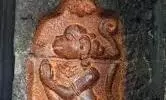15th-Century Inscription Found At Simhachalam Temple
Historian Sai Kumar Kethineedi, a member of Team Of Research On Culture and Heritage (Torch), said the inscription further mentions that this offering, a sacred combination of food and drink, was managed under the stewardship of Gurudasā Jena the Bhoga Parichha.

Visakhapatnam: A remarkable 15th-century inscription discovered in the shrine of Simhachalam has shed light on an intriguing and culturally rich tradition initiated by Kapilendra Deva, the Gajapati ruler of Odisha (r. 1436–1467 CE). Dated to his 25th Regnal year, the inscription reveals that the king instituted the daily offering of Enduri Pitha (a jaggery stuffed turmeric leaf-wrapped round steamed or present day Idli ) and Pāna (a fragrant sweet drink) to Lord Narasimhanatha as part of the majjana abakāśa — the post-bathing ritual of the deity.
Historian Sai Kumar Kethineedi, a member of Team Of Research On Culture and Heritage (Torch), said the inscription further mentions that this offering, a sacred combination of food and drink, was managed under the stewardship of Gurudasā Jena the Bhoga Parichha. Two sets of Enduri and one kuñcā of Pāna were to be presented every morning, and a monthly grant of six tanka ( 6 Rupees in Odiya) was sanctioned to ensure this ritual’s continuity. The offering was given during the tenure of Mahapatra Hari Srichandana, says historian from Odisha Bishnu Mohan Adhikari
Sai Kumar said the king’s devotion was not merely ceremonial but institutional. He ensured the temple's smooth functioning by regulating offerings and making provisions for them through fixed deposits. The record warns that any disruption or negligence in this offering by the designated steward would amount to an act of betrayal against the deity.
This unique practice blends royal devotion, culinary heritage and ritual precision — reaffirming Kapilendra Deva’s role not just as a conqueror and administrator but as a pious devotee with a refined sense of ritual aesthetics. Simhachalam, already renowned for its Eastern Ganga era iconography and temple grandeur, now also stands testimony to Odisha’s sacred diplomacy under the Suryavamsi Gajapatis.
Historians and epigraphists regard this find as one of the earliest documented instances of Enduri and Pāna being formally included in temple rituals, a tradition that continues today in parts of Odisha during Prathamastami and other festive occasions. "Historians are advocating for the revival of these two food items in Simhachalam," said Sai Kumar.

